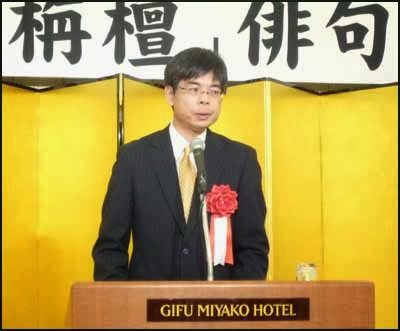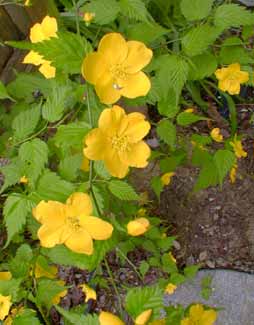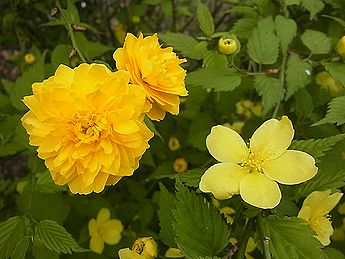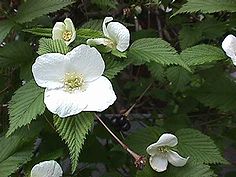:::::::::::::::::::::::::::::::::::::::::::::::::::::::::::::::::::::::::::::::::::::::::::::::::::::
Honeysuckle (nindoo, suikazura)
***** Location: Japan
***** Season: Various, see below
***** Category: Plant
*****************************
Explanation
kigo for early summer
suikazura no hana 忍冬の花 (すいかずらのはな)
honeysuckle flowers
..... nindoo no hana 忍冬の花(にんどうのはな)
suikazura 吸葛(すいかずら)
kinginka 金銀花(きんぎんか)"gold silver flower"
:::::::::::::::::::::::::::::::::::::::::::::::::::::::::::::::::::::::::::::::::::::::::::::::::::::
quote
Nindo or suikazura (honeysuckle)
The honeysuckle;
With every petal that falls,
The voice of the gnats.
Yosa Buson (1716-83)
translated by R.H. Blyth
The Japanese honeysuckle (Lonicera japonica)
blooms from early summer to autumn and, like honeysuckles around the world, can be found twining through light woodlands and hedgerows or perfuming a trellis in the garden. Although its blooms are simple and short-lived, honeysuckle is a magical flower of the night, opening its pale silvery buds at dusk.
The silvery color and delicious perfume are designed to attract moths, which pollinate the flowers as they sip nectar from the base of the blooms. However, daytime bees will occasionally nip a small hole in the tube and "steal" the nectar without brushing past the pollen!

Another Japanese name for honeysuckle is kinginbana, meaning "gold-and-silver flower," as the blooms turn from silvery white to pale gold.
Gardeners also like the western honeysuckle (L. sempervirens), which has clusters of colorful pink buds that open to pale yellow. In Japanese this species is called tsukinukinindo, meaning "pierced honeysuckle," because the stem appears to pierce through its clasping leaves.
I found the honeysuckle above growing in a cascade of flowers in an English hedgerow, and even after keeping the sprigs in a vase for a week, new buds were still opening and sending out an exquisite perfume, especially at night.
source : Japan Times, Aug. 7, 2003
:::::::::::::::::::::::::::::::::::::::::::::::::::::::::::::::::::::::::::::::::::::::::::::::::::::
kigo for early summer
doku utsugi no hana 毒空木の花 (どくうつぎのはな)
flower of Coriaria japonica
:::::::::::::::::::::::::::::::::::::::::::::::::::::::::::::::::::::::::::::::::::::::::::::::::::::
kigo for mid-summer
Hakone utsugi no hana 箱根空木の花 (はこねうつぎのはな)
flower of Weigela coraeensis

*****************************
Worldwide use
Nindoo - japanisches Geißblatt
japanische Heckenkirsche
:::::::::::::::::::::::::::::::::::::::::::::::::::::::::::::::::::::::::::::::::::::::::::::::::::::
India

Quisqualis indica also known as the
Chinese honeysuckle, Rangoon Creeper, and Combretum indicum is a vine with red flower clusters and is found in Asia. It is found in many other parts of the world either as a cultivated ornamental or run wild.
Other names for the plant include Quiscual (in Spanish), Niyog-niyogan (in Filipino), Madhu Malti or Madhumalti (in Hindi), Akar Dani (in Malay) and Radha Manoharam (in Telugu).
The genus translates into Latin for What is that?.
© More in the WIKIPEDIA !
scent of quisqualis -
humming while waiting
for the sunrise
- Shared by Rosie Mann -
Joys of Japan, 2012
:::::::::::::::::::::::::::::::::::::::::::::::::::::::::::::::::::::::::::::::::::::::::::::::::::::
Ireland
Honeysuckle - Irish Name: Féithleann
is pollinated by bees by day and at night the moths are attracted by the wonderful scent, the Elephant Hawkmoth regularly visiting in search of nectar. This is a native plant belonging to the family Caprifoliaceae.
source : wildflowersofireland.net
Spring ramble...
down this lane
the scent of Féitleann
- Shared by John Byrne -
Haiku Culture Magazine, 2013
:::::::::::::::::::::::::::::::::::::::::::::::::::::::::::::::::::::::::::::::::::::::::::::::::::::
Lonicera fragrantissima
is a species of flowering plant in the honeysuckle family known by the common names
winter honeysuckle, fragrant honeysuckle, January jasmine, and sweet breath of spring.

It is native to China and has been an introduced species to other parts of the world.
© More in the WIKIPEDIA !
winter honeysuckle ~
my february bloomer
buds early this year
- Shared by Pat Geyer -
Haiku Culture Magazine, 2013
*****************************
Things found on the way
Plants named UTSUGI (utsuki) ウツギ "blossoms in the sky"
fuji nishiki フジウツギ Buddleja japonica
kibana utsugi キバナウツギ Ukon-type
kogome utsugi コゴメウツギ
mitsuba utsugi ミツバウツギ Staphylea bumalda
nishiki utsugi ニシキウツギ
tani utsugi タニウツギ
toofuji utsugi トウフジウツギ Buddleja lindleyana
tsukubane utsugi ツクバネウツギ
urajiro utsugi ウラジロフジウツギ Buddleja curviflora
flowers during the planting season in mid-summer
tauebana 田植花 (たうえばな) flowers during the rice field planting season
..... tauegusa 田植草(たうえぐさ)
otomebana 早乙女花(さおとめばな)
:::::::::::::::::::::::::::::::::::::::::::::::::::::::::::::::::::::::::::::::::::::::::::::::::::::

source : niccomagazine.hamazo.tv
honeysuckle wine 忍冬酒
A drink beloved by Tokugawa Ieyasu ...
to relax in the evening and sleep well.
徳川家康も愛した幻のお酒忍冬酒(にんどうしゅ)
In the Edo period, the production of this wine was only taught from father to son, it was a top secret family tradition.
The base is a sweet mirin from mikan mandarins of Mikawa, Aichi prefecture.
honeysuckle wine -
I talk to the Shogun
in my dream
Gabi Greve
- Reference : Honeysuckle Wine -
*****************************
HAIKU
Yosa Buson 蕪村 with other translations
蚊の声す忍冬の花の散るたびに
ka no koe su nindoo no hana chiru goto ni
The honeysuckle;
With every petal that falls,
The voice of the gnats.
The voices of mosquitoes,
Whenever the flower of the honeysuckle
Falls.
Of the nindou, Blyth writes:
"The nindou is not a very striking flower, white, and afterwards becoming yellowish. It does not fade in winter, and from this comes its name, "enduring winter.""
"Of all sounds, the voice of the mosquito is the most mysterious, of deeply subtle meaning. Of all flowers, the whitish-yellow 'nindou' is the most forlorn. Each time the voice of the gnats is noticed, the flowers become more remotely near. Each time a flower falls, the sound of the gnats is more profound in the heart."
"The 'nindou' is not a very striking flower... The voice of the mosquito also is very small indeed, not to be heard far away from the ear. We have in this verse two hardly noticeable things, yet they and their chance relationship are clearly perceived and expressed."
Blyth
Mosquitoes humming
each time a honeysuckle flower
falls from the vine.
Tr. Sawa & Shiffert:
ka no koe 蚊の声 the "voice" of a mosquito
. The voice of an animal .
:::::::::::::::::::::::::::::::::::::::::::::::::::::::::::::::::::::::::::::::::::::::::::::::::::::

source : estar.jp/.pc/_photo_view
:::::::::::::::::::::::::::::::::::::::::::::::::::::::::::::::::::::::::::::::::::::::::::::::::::::
a leaf swirls
from a moribund honeysuckle --
dry August
Caleb Wothes
source : Kenya in August 2009
*****************************
Related words
***** . PLANTS IN SUMMER - SAIJIKI
***** . Nintoo Ki 忍冬忌 Ninto Memorial Day .
(Nindooki)
Ishida Hakyo (Ishida Hakyoo) 石田波郷
[ . BACK to WORLDKIGO . TOP . ]
:::::::::::::::::::::::::::::::::::::::::::::::::::::::::::::::::::::::::::::::::::::::::::::::::::::











































